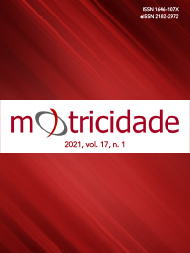Prevalence and sociodemographic factors associated with passive commuting to school: comparison between adolescents from different regions of Brazil
DOI:
https://doi.org/10.6063/motricidade.19453Abstract
The level of physical activity of adolescents has been a concern for public health agencies, suggesting the maximum use of the physical activities available in daily life. This study aimed to compare the prevalence of passive commuting to school and analyze the sociodemographic factors associated with adolescents from two Brazilian cities. The participants of this cross-sectional, epidemiologic, and school-based study were adolescents boys and girls, aged 15 to 18, from a city of Southern Brazil, São José/Santa Catarina (= 1024), and from a city of Northern Brazil city, Manaus/Amazonas (n= 1109). Participants completed a self-administered questionnaire with information regarding commuting to school, age, gender, and Family income. Poisson regression was used to estimate the prevalence ratios and confidence intervals of 95% (CI95%). The adolescents from Santa Catarina were more passive (53.5%; CI95%: 50.1-56.0) than adolescents from Amazonas (37.3%; CI95%: 34.5-39.7) in commuting to school. Female gender and being part of a Family with higher monthly income were associated with increased chances of passively commuting to school in both cities. The ages of 16 and 17 were associated with diminished chances of passively commuting to school in adolescents from Amazonas. Measures to avoid and reduce passive commuting should target, especially, girls and adolescents from higher-income Families.
Keywords: Adolescents, Physical activity, Income.
Downloads
Published
Issue
Section
License
The authors of submitted manuscripts must transfer the full copyright to Journal Motricidade / Sílabas Didáticas Editions. Granting copyright permission allows the publication and dissemination of the article in printed or electronic formats, and copyrights start at the moment the manuscript is accepted for publication. It also allows Journal Motricidade to use and commercialise the article in terms of licensing, lending or selling its content to indexation/abstracts databases and other entities.
According to the terms of the Creative Commons licence, authors may reproduce a reasonable number of copies for personal or professional purposes, but without any economic gain. SHERPA/RoMEO allows authors to post a final digital copy (post-printing version) of the article on their websites or on their institutions' scientific repository.


